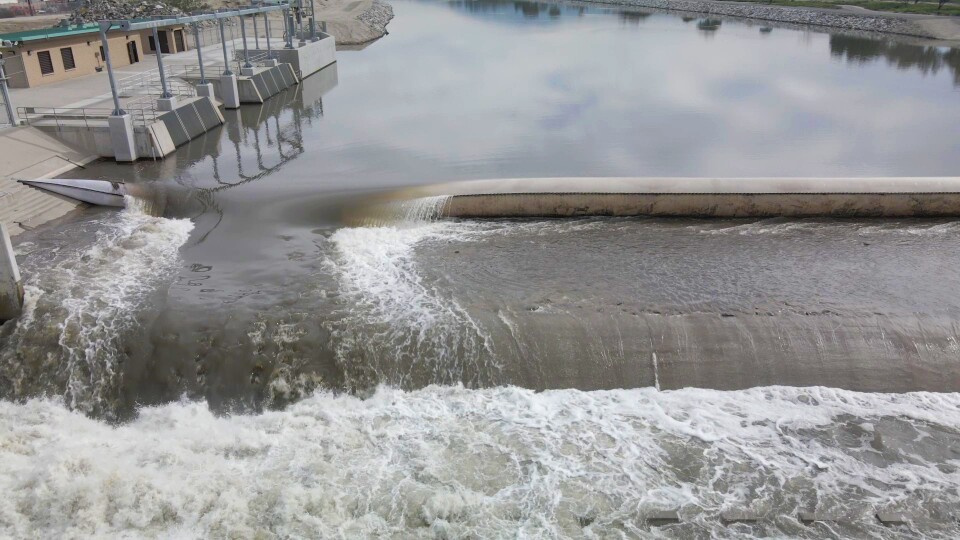Truth matters. Community matters. Your support makes both possible. LAist is one of the few places where news remains independent and free from political and corporate influence. Stand up for truth and for LAist. Make your year-end tax-deductible gift now.
LA's Dry Months Are Just Around The Corner. How Much Stormwater Can We Capture Now?

From January to February, Southern California went from quite dry to overwhelmingly wet, as a series of storms dropped more than a year’s worth of water in just a few weeks, loading up the L.A. River.
Given that our dry months are coming up, just how much of that stormwater were we able to hold on to? And could we be doing better?

How we capture water
The main way that we capture stormwater is by letting it soak into the Earth and travel through the soil into underground reservoirs.
Back in the day, this would happen all across places like the L.A. Basin, but as we paved over much of the area, we lost much of our ability to sequester rainfall.
That’s where spreading grounds, like those in the San Fernando Valley (seen below), come in.

They're huge open areas of gravel and sand where we divert stormwater without destroying nearby neighborhoods. That water then sits in giant pools and percolates downward over time.
Given that roughly a third of L.A. County’s water comes from underground reservoirs each year, it’s important that we keep on filling them.
“We have two missions. One is to protect communities and to capture as much of that water and keep it from being wasted in the ocean,” said Sterling Klippel, assistant deputy director of L.A. County’s Department of Public Works.
There are 27 spreading grounds throughout the county and 14 major dams that can hold water back and slowly release it during dry periods onto those same grounds when our flood channels aren’t being inundated.
When the water is released, it’s often diverted with the help of giant inflatable dams.

How fast the water percolates depends on both the media it’s flowing through and how much sediment is in the water. Brown-looking stormwater has a lot of silt in it, which can slow down absorption rates. Crews go in with heavy equipment during the spring and summer to scrape the spreading grounds clean ahead of the next rainy season.
This year L.A. County has sequestered roughly 100,000 acre-feet of stormwater, about half of what they typically capture during an average year. Last year they captured more than 600,000 acre-feet, or roughly enough water for half of the population of the county. For reference, one acre foot is about the equivalent of a football field flooded with about a foot of water.
L.A. County is able to capture more than 90% of the water that falls in the San Gabriel watershed above the spreading grounds.

The Orange County Water District utilizes a similar system. Drive down the 91 Freeway and you’ll see what looks like a bunch of lakes. They’re actually part of their portfolio of 26 recharge facilities that’ve been built across 1,500 acres over the past 70 years.
They’re able to capture about 220 million gallons of water a day, according to John Kennedy, general manager of the water district.
Can we do more?
Building additional spreading grounds is tough, as we're quite limited on space here.
“The L.A. Basin is very dense and property values are sky high. So unfortunately, doing the spreading grounds and dams around the city is going to be nearly impossible just because of the high price tag,” said Art Castro, manager of the Watershed Management Group at the Los Angeles Department of Water and Power.
Some spreading grounds, like those in Pacoima, are being dug out — but there’s a limit to how deep you can go.
LADWP is considering other options as it works towards the goal of capturing 150,000 acre-feet per year by 2035. They currently capture roughly 83,700 acre-feet.
Vertical storm drains are one consideration. They are 150-foot-deep holes lined with permeable pipe that are allowed to fill with water and drain into the surrounding soil.
LADWP is also looking at utilizing subterranean stormwater capture at an estimated 20 parks throughout the city. That project is currently in the design phase.
What about at the home level?
Yes, you can help fill our underground aquifers from your front yard.
A key feature of the lawn elimination programs here in California is making sure that you put in some sort of water retention feature, like a swale. It's basically a trough that slows down water and lets it soak into the ground, rather than running into the street.
We might no longer have tens of thousands of acres of unpaved farmland throughout the region, but given that 70% of land use is private property here in L.A., widespread use of swales in our yards could make a difference.








